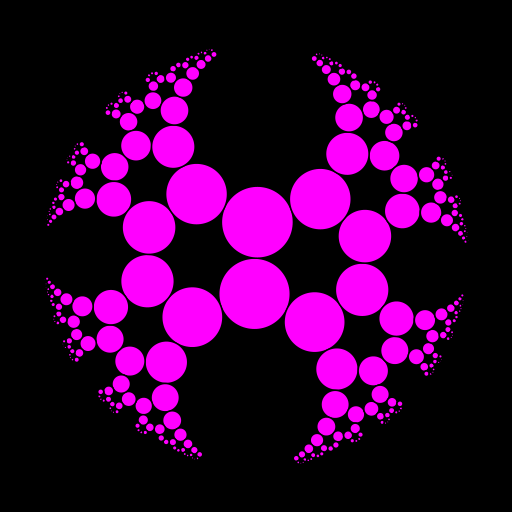An orbit of the modular tessellation
I came across this interesting paper entitled Complex Variables Visualized and written by Thomas Ponweiser.
In particular, I was intrigued by the generalized powers of a Möbius transformation (of a matrix, actually), and their actions on the modular tessellation.
So I firstly implemented the generalized powers in my package PlaneGeometry. Then I wrote the script below to visualize the orbit of the modular tessellation under the action of \(R^t\), \(0 \leqslant t < 3\), with the notations of the paper. The command fplot(u) generates the modular tessellation under the action of \(R^t\) when u is the value of \(t\). Then I use the gifski package to create the animation.
To get the modular transformations \(z \mapsto \frac{az+b}{cz+d}\), I use the unimodular function of the elliptic package. It generates the quadruples \((a,b,c,d)\) of positive integers such that \(ad-bc=1\). Then we can get all such quadruples \((a,b,c,d) \in \mathbb{Z}^4\) by inverting these modular transformations, swapping \(a\) and \(d\) and changing their signs.
library(PlaneGeometry)
library(elliptic) # for the 'unimodular' function
# Möbius transformations
T <- Mobius$new(rbind(c(0,-1), c(1,0)))
U <- Mobius$new(rbind(c(1,1), c(0,1)))
R <- U$compose(T)
# R^t, generalized power
Rt <- function(t) R$gpower(t)
# starting circles
I <- Circle$new(c(0,1.5), 0.5)
TI <- T$transformCircle(I)
# modified Cayley transformation
Phi <- Mobius$new(rbind(c(1i,1), c(1,1i)))
# plotting function ####
n <- 8L
transfos <- unimodular(n)
fplot <- function(u){
opar <- par(mar = c(0,0,0,0), bg = "black")
plot(NULL, asp = 1, xlim = c(-1.1,1.1), ylim = c(-1.1,1.1),
xlab = NA, ylab = NA, axes = FALSE)
draw(unitCircle, col = "black")
for(i in 1L:dim(transfos)[3L]){
transfo <- transfos[,,i]
#
M <- Mobius$new(transfo)
draw(M$compose(Rt(u))$compose(Phi)$transformCircle(I),
border = "black", col = "magenta")
draw(M$compose(Rt(u))$compose(Phi)$transformCircle(TI),
border = "black", col = "magenta")
M <- M$inverse()
draw(M$compose(Rt(u))$compose(Phi)$transformCircle(I),
border = "black", col = "magenta")
draw(M$compose(Rt(u))$compose(Phi)$transformCircle(TI),
border = "black", col = "magenta")
#
diag(transfo) <- -diag(transfo)
M <- Mobius$new(transfo)
draw(M$compose(Rt(u))$compose(Phi)$transformCircle(I),
border = "black", col = "magenta")
draw(M$compose(Rt(u))$compose(Phi)$transformCircle(TI),
border = "black", col = "magenta")
M <- M$inverse()
draw(M$compose(Rt(u))$compose(Phi)$transformCircle(I),
border = "black", col = "magenta")
draw(M$compose(Rt(u))$compose(Phi)$transformCircle(TI),
border = "black", col = "magenta")
#
d <- diag(transfo)
if(d[1L] != d[2L]){
diag(transfo) <- rev(d)
M <- Mobius$new(transfo)
draw(M$compose(Rt(u))$compose(Phi)$transformCircle(I),
border = "black", col = "magenta")
draw(M$compose(Rt(u))$compose(Phi)$transformCircle(TI),
border = "black", col = "magenta")
M <- M$inverse()
draw(M$compose(Rt(u))$compose(Phi)$transformCircle(I),
border = "black", col = "magenta")
draw(M$compose(Rt(u))$compose(Phi)$transformCircle(TI),
border = "black", col = "magenta")
}
}
for(i in 1L:dim(transfos)[3L]){
transfo <- transfos[,,i]
#
M <- Mobius$new(transfo)$compose(T)
draw(M$compose(Rt(u))$compose(Phi)$transformCircle(I),
border = "black", col = "magenta")
draw(M$compose(Rt(u))$compose(Phi)$transformCircle(TI),
border = "black", col = "magenta")
M <- M$inverse()
draw(M$compose(Rt(u))$compose(Phi)$transformCircle(I),
border = "black", col = "magenta")
draw(M$compose(Rt(u))$compose(Phi)$transformCircle(TI),
border = "black", col = "magenta")
#
diag(transfo) <- -diag(transfo)
M <- Mobius$new(transfo)$compose(T)
draw(M$compose(Rt(u))$compose(Phi)$transformCircle(I),
border = "black", col = "magenta")
draw(M$compose(Rt(u))$compose(Phi)$transformCircle(TI),
border = "black", col = "magenta")
M <- M$inverse()
draw(M$compose(Rt(u))$compose(Phi)$transformCircle(I),
border = "black", col = "magenta")
draw(M$compose(Rt(u))$compose(Phi)$transformCircle(TI),
border = "black", col = "magenta")
#
d <- diag(transfo)
if(d[1L] != d[2L]){
diag(transfo) <- rev(d)
M <- Mobius$new(transfo)$compose(T)
draw(M$compose(Rt(u))$compose(Phi)$transformCircle(I),
border = "black", col = "magenta")
draw(M$compose(Rt(u))$compose(Phi)$transformCircle(TI),
border = "black", col = "magenta")
M <- M$inverse()
draw(M$compose(Rt(u))$compose(Phi)$transformCircle(I),
border = "black", col = "magenta")
draw(M$compose(Rt(u))$compose(Phi)$transformCircle(TI),
border = "black", col = "magenta")
}
}
}
# animation ####
library(gifski)
u_ <- seq(0, 3, length.out = 181L)[-1L]
save_gif({
for(u in u_){
fplot(u)
}
}, "ModularTessellation.gif", 512, 512, delay = 1/12, res = 144)







